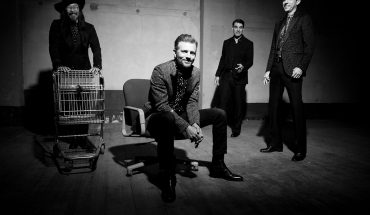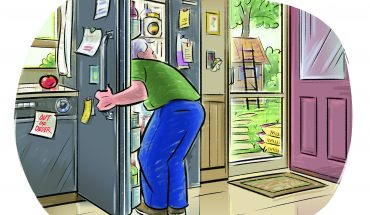by Samantha Gratton | photography by S.P. Murray
Becky Joye appreciates lines and order—but to emphasize her instinct for precision belies the sense of wonder that filters through her mixed-media artwork. Combining familiar objects (water towers, diggers, Ferris wheels) with abstract shots of color, Joye’s work always tells a story, but you might not see it upon first look. Joye’s detail-oriented approach comes in part from her background: Born in Charlotte, Joye took art classes growing up and went on to study architecture at UNC-Charlotte, designing greeting cards and wedding invitations on the side to stay creatively engaged. She worked for several years as an architectural designer, first in Charlotte, then in Austin, Texas, but then she was laid off in 2008. “It was a big moment for me—I realized I didn’t want to be an architect anymore.”
“It was a low point in my life,” she adds with a bit of a laugh. “But it forced me to find the confidence to say that I wanted to be an artist, because I never thought it could be a career. And it’s true, it’s not an easy one. With architecture you know the steps you’re taking; artists don’t really know the path, you figure it out as you go along.”
The Art’s Inspiration
For Joye, forging her path—along with her own voice and style—started with classes at the local art museum (now known as The Contemporary Austin). She had done realistic pencil drawings before, but wanted to learn more about painting, so she studied under contemporary painter Andrew Long. After a 2010 trip to West Texas, she was inspired by its wide-open landscapes and developed a series featuring kites, balloons and a lot of white. Titled In Search of Lightness, it captures the feeling of open space and an open mind. In 2012, Joye and her husband moved to Raleigh to be closer to their families, where she was chosen for the Regional Emerging Artist-in-Residence in 2013 at ArtSpace (she continues to rent studio space there today). It was there that she found a subject she’d come back to time and again: man-made contraptions.
“I like structures,” says Joye.“I’ll see something like a Ferris wheel and think, ‘Oh, I want to do an exploration of that.’” For her Amusement series, she visited amusement parks and carnivals, then used acrylic, pencil and thread on paper to create vivid scenes and mixed-media sculptures with moving parts. “That one was a fun one because I rode on rides,” she says, “though I discovered I was too old for them.” Similarly, Joye’s Hunting for Mysteries features lighthouses, boats and trucks influenced by a trip to Iceland. She worked on that series during a month-long residency at the Millay Colony for the Arts in Austerlitz, New York in 2015. The series became a solo show at the Wally Workman Gallery in Austin, Texas the following spring, and they continue to represent her and show other pieces of her work.
Another series, Industrial Fabric, coincides with her style of whimsical structures and strong lines, but the medium moves toward Japanese fabrics in muted colors and geometric shapes sewn together onto the paper, in addition to the use of acrylic and pencil. For these, Joye learned to sew and played with sewing on paper to create collages of man-made creations through fabric. Foy Joye, seeing anything from a turbine to a water tower along the side of the road can lead to visualizations of creatures or figures through color and fabric.
Art as therapy
A few months after her solo show in Austin, Joye’s son Jack was born, an event that inspired her Labor Intensive series. While the work appears vibrant and playful, it actually has darker undertones, as she used it to work through the emotions of a difficult pregnancy, traumatic birth and tough recovery. “They’re colorful, but not joyful,” says Joye. In these paintings, twisted rope, knotted ribbon and pieces of fabric—signs of the anticipation and tension she felt through pregnancy and childbirth—pop against deep red, blue and green backgrounds. “I used a colored background so I could get a little messier,” says Joye, a stark contrast to her previous habit of working against a white background. “My artwork had always been very meticulous and clean, but things didn’t feel that way anymore.” To create the paintings, Joye often worked from physical models, knotting rope or pulling clothing from the hamper. “I think I painted a lot of references to laundry because I was feeling really domestic at the time,” says Joye.
Joye has had fewer art shows since becoming a mother, now that her time is limited to preschool and nap hours. “It’s good because I come and focus on it,” says Joye. “But I have a harder time getting my mind wandering and coming up with ideas.” Last summer, her younger sister Amy passed away. Joye processed that loss and its impact on her family through therapy and through her art: A few pieces use layers of pink fabric and thread to represent a pretty exterior, with unknowns beneath the surface. In a piece titled Memento, a collage of cooling towers comes to represent her two sisters and herself; hers is in calming shades of green and her sister Melissa’s a mosaic of reds, but Amy’s is made only of thread, depicting her absence. “These all mean something to me, but not to anybody else,” says Joye. “I don’t know if I’ll ever sell them.”
Becky Joye’s Future
While Joye’s art has primarily served to process the upheavals in her personal life for the last few years, Joye feels like she is getting back to her old self now. “I really connect to the word transcendence for what I want to do now in my work—overcome grief, anxiety and physical setbacks by connecting to my inner child.”
One way Joye is doing that is by creating scenes for a children’s book proposal. Currently untitled, the book will focus on a young girl building a house. She received the 2019 Professional Development Grant from the United Arts Council of Raleigh and Wake County to produce the artwork, which draws from pictures from her childhood. The scenes are reminiscent of many of Joye’s earlier pieces, featuring construction vehicles in playful colors, celebratory geometric shapes and wide-open spaces that spark a childlike curiosity. Whether it is through a children’s book, playful structures or moody collages, Joye wants people to feel, well, joyful when experiencing her art: “I want them to feel a sense of wonder, to step into their imaginations.”







